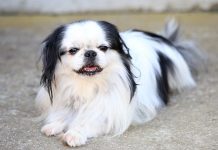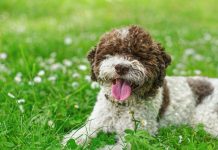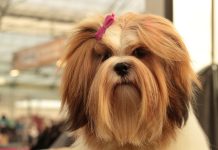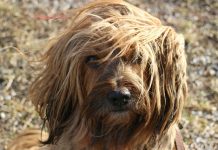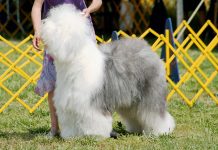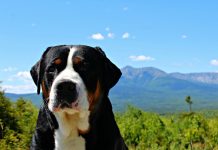History and Origins of the Labradoodle Breed:

The Labradoodle is a hybrid breed that originated in Australia in the late 20th century. The breed was developed with the intention of creating a hypoallergenic guide dog for visually impaired individuals who needed assistance but also suffered from allergies to dog dander.
The Labradoodle’s story begins with Wally Conron, a breeding manager at the Royal Guide Dogs Association of Australia in the 1970s. A visually impaired woman from Hawaii contacted the organization, requesting a guide dog that would not aggravate her husband’s allergies. Wally Conron decided to cross a Standard Poodle with a Labrador Retriever, knowing that Poodles are low-shedding and considered hypoallergenic.
The first successful cross between a Poodle and a Labrador Retriever resulted in a dog named Sultan, who had a hypoallergenic coat suitable for the woman’s husband. This marked the beginning of the Labradoodle breed.
Since then, Labradoodles have gained popularity worldwide for their friendly temperament, intelligence, and hypoallergenic qualities. They are now recognized as a designer breed and are often used as therapy dogs, service dogs, and beloved family pets.
Physical Characteristics and Appearance of Labradoodles:
Labradoodles are known for their diverse appearances, which can vary based on factors such as size, coat type, and generation (F1, F1B, F2, etc.). Here are some common physical characteristics and appearances of Labradoodles:
- Coat Types:
- Fleece Coat: Soft, wavy, and non-shedding. This coat type is typically hypoallergenic and requires regular grooming.
- Wool Coat: Dense, curly, and low-shedding. Wool coats are also considered hypoallergenic and require regular grooming to prevent matting.
- Hair Coat: Straight or wavy with minimal curls. Hair coats may shed slightly and require less grooming compared to fleece or wool coats.
- Colors:
- Labradoodles come in a wide range of colors, including black, chocolate, cream, apricot, red, silver, and parti-color (combination of two or more colors).
- Size:
- Labradoodles are available in various sizes, including Standard, Medium, Miniature, and Toy. Standard Labradoodles can weigh between 50 to 65 pounds and stand 21 to 24 inches tall at the shoulder. Miniature Labradoodles weigh 15 to 30 pounds and stand 14 to 16 inches tall, while Toy Labradoodles weigh less than 15 pounds and stand under 14 inches tall.
- Body Structure:
- Labradoodles have a sturdy and athletic build, similar to their Labrador Retriever parent. They have expressive eyes, floppy ears, and a wagging tail.
Overall, Labradoodles are known for their friendly and sociable nature, making them excellent companions for families and individuals alike. Their hypoallergenic coat and intelligence make them suitable for individuals with allergies or those seeking a versatile and trainable canine companion.
Labradoodle Temperament and Personality Traits:
Labradoodles are renowned for their friendly, outgoing, and intelligent nature, combining the best traits of their Labrador Retriever and Poodle parents. Here are some key temperament and personality traits commonly associated with Labradoodles:
- Friendly and Sociable:
- Labradoodles are highly social dogs that thrive on companionship and interaction with people and other animals. They are known for their affectionate and loving demeanor, making them excellent family pets.
- Intelligent and Trainable:
- Labradoodles inherit the intelligence of both the Labrador Retriever and Poodle breeds, making them highly trainable and responsive to positive reinforcement training methods. They excel in obedience training, agility, and canine sports.
- Playful and Energetic:
- Labradoodles are active dogs that enjoy playtime and exercise. They have a playful and energetic personality, making them well-suited for families with active lifestyles.
- Adaptable and Versatile:
- Labradoodles are adaptable to various living environments, including apartments, suburban homes, or rural areas, as long as they receive adequate exercise and mental stimulation.
- Good with Children:
- Labradoodles are generally good-natured and patient with children, making them popular family pets. They enjoy playing and interacting with kids but should always be supervised, especially with younger children.
- Alert and Watchful:
- Labradoodles have a protective instinct and can serve as excellent watchdogs. They will alert their owners to unfamiliar sounds or visitors but are not typically aggressive.
- Affectionate and Loyal:
- Labradoodles form strong bonds with their families and are known for their loyalty and devotion. They thrive on human companionship and enjoy being included in family activities.
Training and Socialization Needs for Labradoodles:
Proper training and socialization are essential for ensuring that Labradoodles grow into well-behaved and well-adjusted dogs. Here are some training and socialization needs specific to Labradoodles:
- Early Socialization:
- Begin socializing your Labradoodle puppy early to expose them to various people, animals, sights, and sounds. Positive experiences during puppyhood help prevent fearfulness and aggression later in life.
- Basic Obedience Training:
- Labradoodles are eager to please and respond well to positive reinforcement training techniques, such as rewards-based training and clicker training. Teach basic commands like sit, stay, come, and heel.
- Consistent Exercise Routine:
- Labradoodles are active dogs that require regular exercise to maintain their physical and mental well-being. Provide daily walks, playtime, and interactive games to keep them stimulated.
- Grooming and Handling:
- Introduce your Labradoodle to grooming routines early, including brushing, bathing, nail trimming, and ear cleaning. This helps them become comfortable with grooming and handling procedures.
- Behavioral Training:
- Address any behavioral issues such as jumping, mouthing, or leash pulling through positive reinforcement and consistency. Consult with a professional dog trainer if needed.
- Structured Play and Mental Stimulation:
- Engage your Labradoodle in puzzle toys, interactive games, and training sessions to challenge their minds and prevent boredom.
By providing positive training, socialization, and plenty of love and attention, you can help your Labradoodle become a well-mannered, confident, and happy companion. Regular training sessions and quality time spent together strengthen the bond between you and your Labradoodle.
Health Considerations and Common Issues in Labradoodles:
Labradoodles are generally healthy dogs, but like all breeds, they may be prone to certain health conditions. Responsible breeding practices and regular veterinary care can help mitigate potential health issues. Here are some common health considerations and issues in Labradoodles:
- Hip Dysplasia:
- Labradoodles, like their parent breeds (Labrador Retrievers and Poodles), may be susceptible to hip dysplasia, a genetic condition where the hip joint doesn’t develop properly. This can lead to arthritis and mobility issues if severe.
- Elbow Dysplasia:
- Elbow dysplasia is another orthopedic condition that can affect Labradoodles, causing lameness and discomfort. Regular check-ups and early intervention can help manage this condition.
- Progressive Retinal Atrophy (PRA):
- PRA is an inherited condition that causes degeneration of the retina, leading to vision loss over time. Labradoodles should undergo regular eye exams to detect PRA early.
- Allergies:
- Labradoodles are often marketed as hypoallergenic due to their low-shedding coat, but some individuals may still trigger allergies in sensitive individuals. Regular grooming and cleaning can help reduce allergens.
- Ear Infections:
- Labradoodles, especially those with floppy ears, are prone to ear infections due to moisture and debris buildup. Regular ear cleaning and inspection are essential for preventing infections.
- Bloat (Gastric Dilatation-Volvulus):
- Large and deep-chested breeds like Labradoodles may be at risk of bloat, a life-threatening condition where the stomach twists, cutting off blood flow. Feed multiple small meals per day and avoid vigorous exercise after meals to reduce the risk.
- Skin Issues:
- Labradoodles may develop skin allergies or dermatitis, leading to itching, redness, and irritation. A nutritious diet and proper grooming can help maintain healthy skin and coat.
Living with a Labradoodle: Suitable Environments and Lifestyle Considerations:

Labradoodles are adaptable dogs that can thrive in various living environments, but they require regular exercise, mental stimulation, and social interaction. Here are some factors to consider when living with a Labradoodle:
- Exercise Needs:
- Labradoodles are active dogs that require daily exercise to stay healthy and prevent boredom. Aim for at least 30-60 minutes of moderate to vigorous exercise per day, such as walks, runs, fetch, or interactive play.
- Grooming Requirements:
- Labradoodles have a coat that can range from curly to wavy and requires regular grooming to prevent matting and tangles. Brush their coat several times a week and schedule professional grooming as needed.
- Training and Socialization:
- Labradoodles are intelligent and trainable but require consistent training and positive reinforcement. Socialize them early with people, animals, and different environments to prevent behavioral issues.
- Family Interaction:
- Labradoodles thrive in homes where they receive plenty of attention and interaction from their families. They are excellent companions for active families with children but should be supervised around young kids.
- Indoor vs. Outdoor Living:
- Labradoodles can adapt to apartment living provided they receive enough exercise and mental stimulation. However, they enjoy having access to a fenced yard where they can run and play safely.
- Veterinary Care:
- Schedule regular veterinary check-ups, vaccinations, and preventive care (such as flea and tick prevention) to ensure your Labradoodle’s health and well-being.
By understanding the health considerations and lifestyle needs of Labradoodles, you can create a loving and enriching environment for your canine companion. Regular exercise, grooming, training, and veterinary care are key to a happy and healthy life for your Labradoodle.
Labradoodle Variations and Breeding Practices
Labradoodles are a popular designer breed resulting from the intentional crossbreeding of Labrador Retrievers and Poodles. Due to their growing popularity, Labradoodles come in various variations and are bred using different methods. Here’s an overview of Labradoodle variations and breeding practices:
Variations of Labradoodles:
- Generation:
- Labradoodles can be categorized into different generations based on their ancestry:
- F1 (First Generation): A direct cross between a purebred Labrador Retriever and a purebred Poodle, resulting in a 50/50 mix.
- F1B (First Generation Backcross): The offspring of an F1 Labradoodle bred back to a Poodle. This generation is often more hypoallergenic.
- F2 (Second Generation): The offspring of two F1 Labradoodles bred together.
- Multi-Generational (e.g., F2B, F3, etc.): Labradoodles that are further bred from F1 or F2 crosses to achieve specific traits or characteristics.
- Labradoodles can be categorized into different generations based on their ancestry:
- Coat Type:
- Labradoodles can have different coat types, influenced by their Poodle parentage:
- Fleece Coat: Soft, wavy, and often non-shedding. This coat type is desirable for allergy sufferers.
- Wool Coat: Dense, curly, and low-shedding. Also considered hypoallergenic.
- Hair Coat: Straight or slightly wavy, and may be more prone to shedding.
- Labradoodles can have different coat types, influenced by their Poodle parentage:
- Size:
- Labradoodles come in various sizes depending on the size of the Poodle parent used in breeding:
- Standard: Typically 21 to 24 inches tall and weighing 50 to 65 pounds.
- Medium: Generally 17 to 20 inches tall and weighing 30 to 45 pounds.
- Miniature: Approximately 14 to 16 inches tall and weighing 15 to 30 pounds.
- Toy: Less than 14 inches tall and weighing under 15 pounds.
- Labradoodles come in various sizes depending on the size of the Poodle parent used in breeding:
Breeding Practices for Labradoodles:
- Purpose-Bred Labradoodles:
- Responsible breeders carefully select parent dogs based on health, temperament, and desired traits to produce well-rounded Labradoodles suitable for specific purposes (e.g., service dogs, therapy dogs, family companions).
- Health Testing:
- Ethical breeders conduct health screenings for genetic disorders common in Labrador Retrievers and Poodles, such as hip dysplasia, elbow dysplasia, progressive retinal atrophy (PRA), and others. This helps ensure healthier puppies.
- Focus on Temperament:
- Good breeders prioritize temperament and personality traits, aiming to produce Labradoodles with friendly, sociable, and trainable characteristics suitable for family life.
- Hypoallergenic Traits:
- Some breeders specifically focus on breeding Labradoodles with hypoallergenic coats (e.g., fleece or wool coats) to meet the needs of allergy sufferers.
- Ethical Crossbreeding:
- Ethical breeding practices involve responsible crossbreeding to improve the overall health and quality of the Labradoodle breed while avoiding harmful traits associated with inbreeding or poor breeding practices.
- Education and Transparency:
- Reputable breeders educate prospective owners about Labradoodles, their care requirements, and potential challenges. They provide ongoing support and maintain transparency about the breeding process and lineage of their puppies.
When choosing a Labradoodle, it’s essential to work with a reputable breeder who prioritizes the health, temperament, and well-being of their dogs. Avoid purchasing Labradoodles from puppy mills or irresponsible breeders who prioritize profit over the welfare of the dogs. A well-bred Labradoodle from a responsible breeder is more likely to be healthy, well-adjusted, and a wonderful addition to your family.
50 Best Names with Meanings for Labradoodles
Naming a Labradoodle can be a fun and exciting process that reflects their unique personality and characteristics. Here are 50 creative names with meanings for Labradoodles:
- Biscuit – Sweet and golden, like a delicious biscuit.
- Mocha – Rich brown color resembling the coffee.
- Buddy – A friendly companion for life.
- Willow – Graceful and elegant, like a willow tree.
- Oreo – Black and white, like the popular cookie.
- Scout – Adventurous and always exploring.
- Hazel – Warm brown color resembling hazelnuts.
- Bailey – Gentle and affectionate.
- Rosie – Sweet and charming, like a rose.
- Teddy – Cuddly and lovable, like a teddy bear.
- Maple – Sweet and syrupy, like maple syrup.
- Archie – Spirited and full of personality.
- Cleo – Bright and clever, like Cleopatra.
- Coco – Dark and rich, like cocoa.
- Sunny – Always cheerful and bright.
- Winston – Noble and distinguished.
- Poppy – Vibrant and full of life.
- Finn – Adventurous and spirited.
- Minnie – Small and adorable, like Minnie Mouse.
- Ginger – Fiery and full of zest.
- Dexter – Clever and sharp-witted.
- Luna – Serene and ethereal, like the moon.
- Rusty – Rust-colored and charming.
- Phoebe – Bright and radiant.
- Toby – Loyal and faithful.
- Willow – Graceful and serene.
- Milo – Playful and energetic.
- Honey – Sweet and affectionate.
- Oliver – Friendly and outgoing.
- Daisy – Bright and cheerful, like a daisy flower.
- Rocky – Strong and resilient.
- Lola – Bold and confident.
- Charlie – Happy-go-lucky and friendly.
- Mabel – Gentle and kind-hearted.
- Zeus – Mighty and powerful.
- Sophie – Elegant and graceful.
- Riley – Spirited and lively.
- Sandy – Playful and full of energy.
- Marley – Fun-loving and mischievous.
- Stella – Bright and shining.
- Max – Strong and dependable.
- Roscoe – Adventurous and bold.
- Ivy – Green and lively, like ivy leaves.
- Cody – Trustworthy and loyal.
- Penny – Bright and shiny, like a penny.
- Olive – Unique and distinctive.
- Winnie – Sweet and lovable.
- Finnegan – Spirited and lively.
- Harper – Graceful and sophisticated.
- Jasper – Elegant and refined.
Choose a name that resonates with your Labradoodle’s personality, appearance, or characteristics to create a special bond between you and your furry friend. Whether you prefer classic names or unique ones, there’s a perfect name out there for your Labradoodle!

In conclusion, this Labradoodle breed guide has provided a comprehensive overview of this popular and versatile hybrid breed. Throughout our exploration, we’ve covered the origin, characteristics, and essential considerations for owning a Labradoodle. Known for their intelligence, friendly nature, and hypoallergenic coat, Labradoodles make excellent family pets and companions for individuals seeking a loyal and affectionate canine companion. They thrive in various environments and excel in roles such as therapy or service dogs due to their trainable nature and gentle temperament. As you consider bringing a Labradoodle into your life, may you appreciate their unique qualities and form a strong bond with this wonderful breed, creating lasting joy and companionship together.








